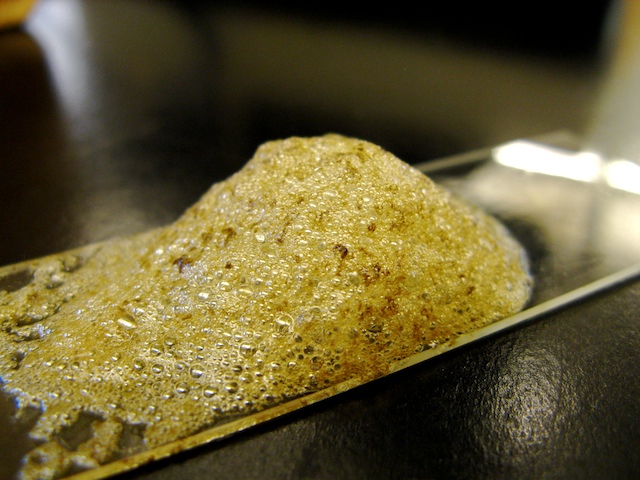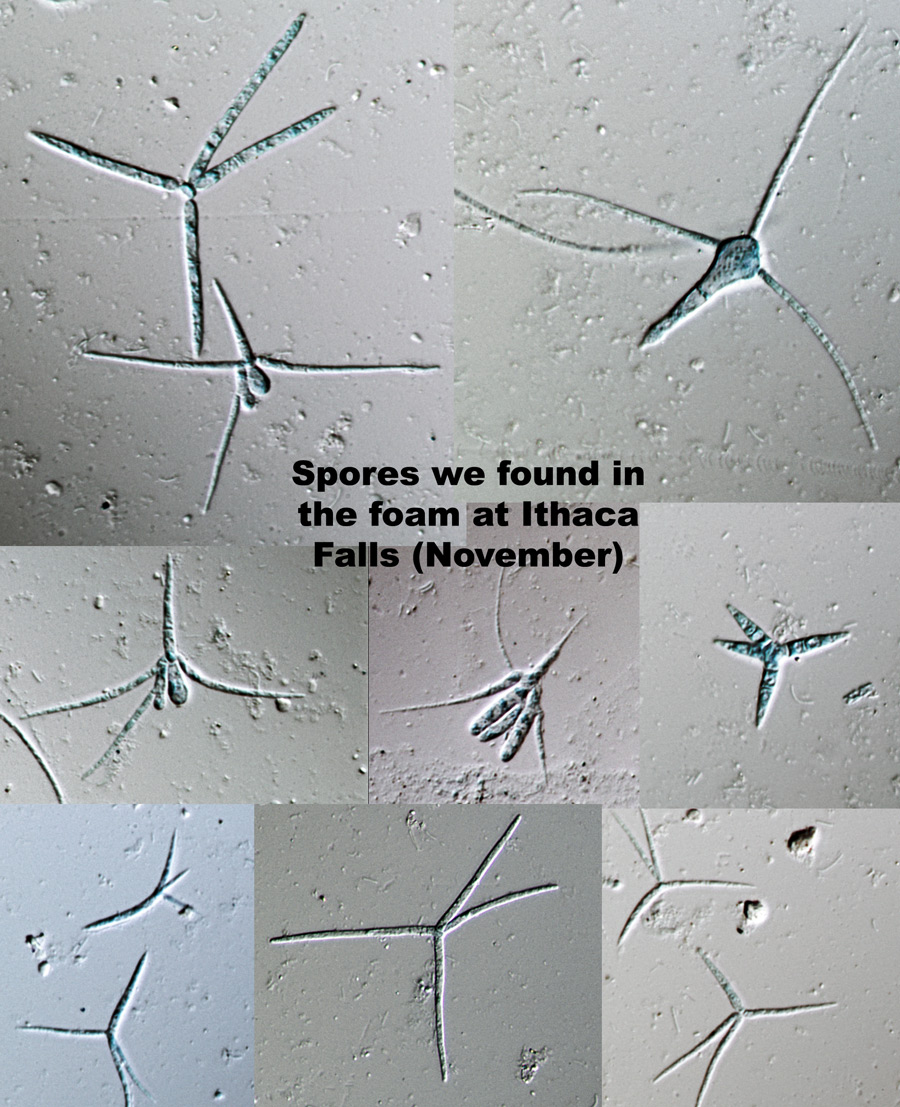Fungi in streams: a leaf nightmare
If I was a leaf, I wouldn’t want to fall into a stream. I’d probably try my hardest to get myself into some kind of a dried flower arrangement, or pressed onto a greeting card as an emblem of autumn. But I would stay away from streams. Streams don’t look like they’d pose much of a danger; after all, they’re just water. But what some leaves don’t realize is that in that water are hundreds of tiny fungi and bacteria just waiting to attack them and break them down, piece by piece, to their simpler elements. And this, for a leaf, must be a very frightening prospect.
 A daunting collection of leaf-eating fungi lurks in the waters of freshwater streams. A few are basidiomycetes or oomycetes, but most are ascomycetes and their asexual stages. Stream-dwelling asexual fungi are frequently dubbed Ingoldian hyphomycetes, in honor of the mycologist C.T. Ingold, who first described them in detail. The Ingoldian hyphomycetes include roughly 290 species, including both ascomycetes and basidiomycetes (Shearer et al., n.d.). They are the most commonly studied group of aquatic fungi, and are the main decomposers of hapless leaves that fall into flowing stream waters. You can easily find the spores of Ingoldian fungi by looking in the foam that accumulates in fast-flowing streams–their unique shape (more on that later) means they are easily trapped in bubbles.
A daunting collection of leaf-eating fungi lurks in the waters of freshwater streams. A few are basidiomycetes or oomycetes, but most are ascomycetes and their asexual stages. Stream-dwelling asexual fungi are frequently dubbed Ingoldian hyphomycetes, in honor of the mycologist C.T. Ingold, who first described them in detail. The Ingoldian hyphomycetes include roughly 290 species, including both ascomycetes and basidiomycetes (Shearer et al., n.d.). They are the most commonly studied group of aquatic fungi, and are the main decomposers of hapless leaves that fall into flowing stream waters. You can easily find the spores of Ingoldian fungi by looking in the foam that accumulates in fast-flowing streams–their unique shape (more on that later) means they are easily trapped in bubbles.
Besides the aquatic fungi, streams are also home to some terrestrial fungi that variously find their way there, often by hitching a ride on leaves or other materials that fall in, or perhaps by tossing their spores into the flowing waters. It has been hypothesized that most aquatic fungi evolved from terrestrial fungi whose spores frequently landed in streams. As a result of this evolutionary history, several genera of fungi, such as Ascotaiwania and Annulatascus, include both terrestrial and aquatic species (Wong et al., 1998).
Although they may be scary for leaves, aquatic fungi are looked upon pretty favorably by the other stream dwellers. This is because fungi —especially the Ingoldian hyphomycetes— supply much of the energy in stream ecosystems. Ingoldian hyphomycetes eat the tough lignin and cellulose components of leaves that fall into streams and transfer the energy from the leaves into forms (proteins, fats, phosphate minerals, carbohydrates, etc.) that other freshwater animals can process. These leaves and other organic materials that fall into streams–which collectively are called allochthonous materials–have been estimated to provide 50-99% of the energy in freshwater communities (Barlocher and Kendrick, 1974).
Besides leaves, some aquatic fungi can also degrade tough animal products such as insect exoskeletons, hair, and fish scales. A few are also equipped with specialized enzymes to digest wood that falls into streams (Wong et al., 1998).
 If allochthonous materials haven’t been digested by fungi, stream animals have a hard time digesting them and end up pooping out the majority of what they eat. Without being initially processed by fungi, as much as 95% of leaf litter can be pooped out by stream animals, suggesting that they are only able to retain the remaining 5% for use in their bodies (Barlocher and Kendrick, 1974). This small percentage of non-pooped material does not contain sufficient energy to support the necessary biological processes of most freshwater fishes. (Luckily, when this happens there are usually fungi around to digest their poop and make its energy available for the rest of the stream community).
If allochthonous materials haven’t been digested by fungi, stream animals have a hard time digesting them and end up pooping out the majority of what they eat. Without being initially processed by fungi, as much as 95% of leaf litter can be pooped out by stream animals, suggesting that they are only able to retain the remaining 5% for use in their bodies (Barlocher and Kendrick, 1974). This small percentage of non-pooped material does not contain sufficient energy to support the necessary biological processes of most freshwater fishes. (Luckily, when this happens there are usually fungi around to digest their poop and make its energy available for the rest of the stream community).
Although “energy flow” sounds like a sleek and elegant process, the reality is a bit woollier. A series of competitive and predatory interactions are involved: When a leaf falls into a stream, spores produced by Ingoldian hyphomycetes float by and their special shapes help them attach to leaf surfaces. Spores of these fungi are commonly tetraradiate–imagine a tripod shape with an extra spike on top, or a jack. Tetraradiate spores can adhere and germinate very quickly (important when you’re tumbling rapidly down a stream). As they attach to the leaf, the spores germinate at the points of contact to attach more firmly. From there they grow into the leaf and begin to eat it.
Autumn leaves are hardly sterile, and typically come with their own collections of terrestrial fungi. These fungi are an early competitive factor for Ingoldian hyphomycetes, but their prevalence drops off as the leaf becomes submerged and its temperature falls–two conditions for which aquatic but not terrestrial fungi have developed adaptations (Wong et al., 1998).
The first Ingoldian hyphomycetes to arrive on a fallen leaf are usually the ones that dominate throughout its digestion. Typically there are four to eight dominant species on any given leaf, and these species change from leaf to leaf. Various rare species come and go, especially during the early stages of digestion (Barlocher, 1982).
 Bacteria also enter the leaf community and join in breaking down tough materials. Early scientific research on leaf litter decomposition focused almost exclusively on these bacteria, but recent work suggests that not only are fungi needed to start the initial break-down of leaves, but that fungi are the principle organisms involved in converting leaf materials to a more palatable form (Pascoal and Cã¡ssio, 2004). Bacteria and aquatic fungi compete for available leaf space–fungi are often on the losing side of this battle–but sometimes the bacteria and fungi coexist, each focusing on the types of materials they are best equipped to digest: low molecular weight compounds for bacteria and high molecular weight compounds for fungi (Mille-Lindblom, 2005).
Bacteria also enter the leaf community and join in breaking down tough materials. Early scientific research on leaf litter decomposition focused almost exclusively on these bacteria, but recent work suggests that not only are fungi needed to start the initial break-down of leaves, but that fungi are the principle organisms involved in converting leaf materials to a more palatable form (Pascoal and Cã¡ssio, 2004). Bacteria and aquatic fungi compete for available leaf space–fungi are often on the losing side of this battle–but sometimes the bacteria and fungi coexist, each focusing on the types of materials they are best equipped to digest: low molecular weight compounds for bacteria and high molecular weight compounds for fungi (Mille-Lindblom, 2005).
In the later stages of leaf degradation, Ingoldian hyphomycetes are faced with grazers like nematodes, amoebae, and rotifers, which seek out and eat areas of leaves with large amounts of fungal mycelium (Wong et al., 1998). It turns out that not only are these animals attracted to fungal areas on leaves because the leaf is more palatable, but also perhaps because the fungal mycelium provides them with a valuable source of nutrition (Kendrick, 2000).
Don’t worry, fungi often get the last word when predacious fungi turn up to trap and feed on nematodes, amoebae, and rotifers, thus adding greater complexity to the aquatic food web. To wrap it all up, shredding insects like stone fly larvae eat all the aforementioned organisms as well as the digested leaves. The crumbs that they generate wash downstream and are captured by filter feeders like baby caddis flies. And any of these bugs might get eaten by carnivores like fish (Barlocher and Kendrick, 1974). With each step of this food web, energy is transferred from one organism to another, and from one trophic (energy) level of a freshwater community to the next. And so an entire food web is built around a community of fungi and a poor defenseless leaf.
- Barlocher, F. 1982. On the ecology of Ingoldian hyphomycetes. BioScience 32:581-586.
- Barlocher, F. and B. Kendrick. 1974. Dynamics of the fungal population on leaves in a stream. The Journal of Ecology 62: 761-791.
- Kendrick, J. 2000. The Fifth Kingdom, 3rd ed. Newburyport, MA: Focus Publishing.
- Mille-Lindblom, C. 2005. Interactions between bacteria and fungi on aquatic detritus: causes and consequences. (Ph.D. diss., Uppsala University, 2005. ) Digital Comprehensive Summaries of Uppsala Dissertations from the Faculty of Science and Technology 46:42pp.
- Pascoal, C. and F. Cassio. 2004. Contribution of Fungi and Bacteria to Leaf Litter Decomposition in a Polluted River. Appl Environ Microbiol. 70: 5266-5273.
- Shearer, C., H. Raja, and J.P. Schmidt. N.d. Freshwater ascomycetes and their anamorphs. Department of Plant Biology, University of Illinois, and U.S. National Park Service. [Online] Accessed: 11/27/07.
Editor’s Note: I just can’t resist adding these notes, can I? In samples of foam from below Ithaca Falls, we found spores from a handful of different Ingoldian species. It’s a good idea to dribble the foam right onto a slide and let it settle there. Otherwise your spores will adhere to the walls of your collecting vessel as the bubbles subside on the way home, and your foam will seem oddly spore-free.
In the big image above, Tetracladium marchalianum is the one at the bottom with the cheeky dangly bits; the other I don’t recognize. The image on the lower right is a compilation of spores from a single foam sample taken below Ithaca Falls on a cool November day.


Nice article, anonymous graduate student!
Enjoyed this very much. Some of your readers might be interested in a week long seminar given on this subject by Carol Shearer and Raja noted in your bibliography. The course will be at Eagle Hill, Maine 28 Sept to 4 Oct. For details contact the Humbold Research Station at http://www.eaglehill.us
Laurie Leonard
Very nice indeed!
I’m astonished by the spore shapes. Are these bizarre to the experienced mycological eye? Are there even odder spores out there? Perhaps, dear talented anon. grad. student, you’d consider doing another piece on spore shapes?
These are certainly odd (at least for spores that don’t live in a stream). Does it get odder than this? Yep. Check this out!
[…] public links >> streams Fungi in streams: a leaf nightmare First saved by RichardLiriano | 1 days ago “Labor†Day First saved by rubenscalixto | 15 […]